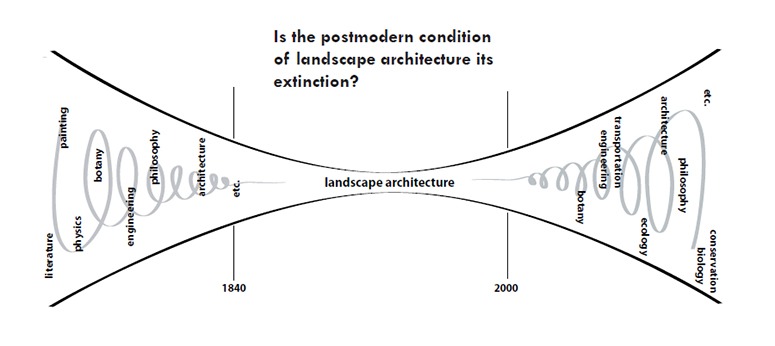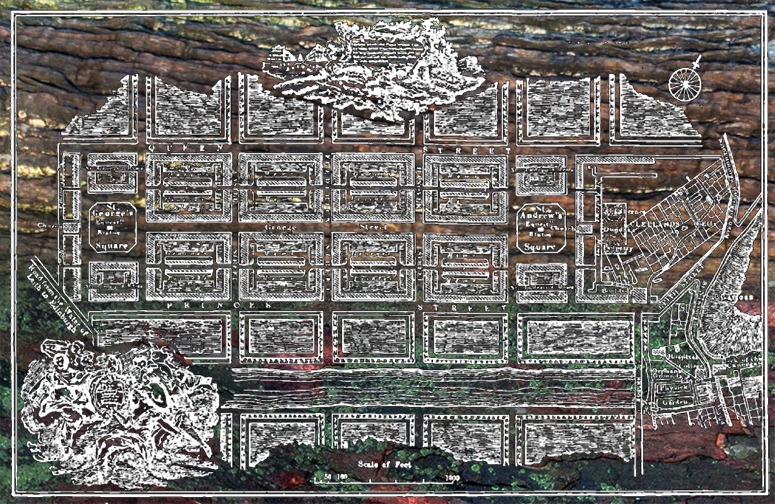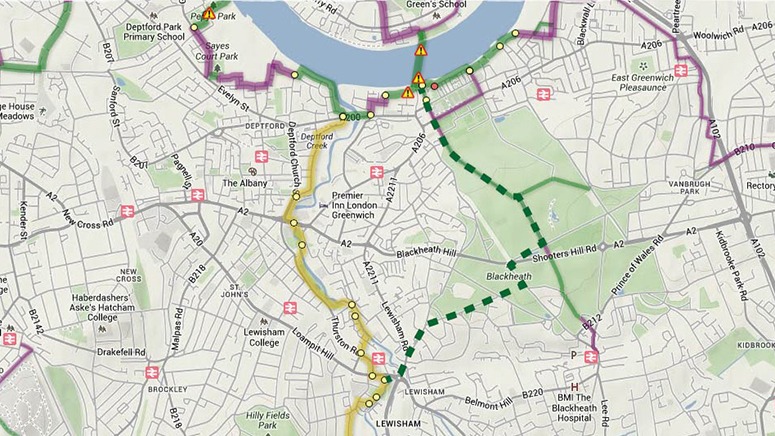
Landscape architecture: an apocalyptic manifesto, was the title of a landscape architecture manifesto published in 2004 by Heidi Hohmann and Joern Langhorst (and republished as ‘Landscape Architecture: A Terminal Case?’ in Landscape Architecture Magazine 95, no. 4 (April 2005): 26-45.). The original manifesto is still available as a pdf document. The Hohmann-Langhorst diagnosis was as excellent. Their prognosis was pessimistic and melancholic.
Having a nostalgic affection for manifestos, I responded with my own manifesto – and plan to mark its 10th anniversary with a revised version.
The above diagram, from the Hohmann-Langhorst article, shows the disciplines from which landscape architecture emerged and the disciplines into which they expected it to dissolve. Worldwide, this has definitely not been landscape architecture’s fate in the last decade. It has had a great many successes without, in my view, coming near to realising its full potential.
There is a great contrast between the two countries (Britain and America) which gave birth to landscape architecture as an organized profession. Landscape architecture is flourishing in the US and stagnant in the UK. It could be that the Hohmann-Langhorst article stimulated the US profession to examine its navel and engage in renewal and re-generation. In part, the regeneration has come from the body of theory known as Landscape Urbanism. Proponents have had many competition successes and advocates of New Urbanism feel themselves under threat. Andres Duany and Emily Talen have responded with a book on Landscape Urbanism and Its Discontents: Dissimulating the Sustainable City. The blurb to their book (which I have not yet read) states that ‘While there is significant overlap between Landscape Urbanism and the New Urbanism, the former has assumed prominence amongst most critical theorists, whereas the latter’s proponents are more practically oriented.’ This is despite the fact that Landscape Urbanists have done a poor job of explaining themselves. They should be grateful to Ian Thompson for his account of its Ten Tenets – and I hope his clarity will stimulate the much-needed revival of English landscape architecture. It is of interest that one of the landscape architects with the clearest vision of where the profession should be heading was born in the UK and works in the US – see this interview, in which Time Magazine describes James Corner as an Urban Dreamscaper.
Category Archives: Sustainable design
Freshkills Park, New York City – a Landscape Urbanism project by James Corner
With luck, I will have to change my mind when it is completed. But my present view of James Corner’s design for Freshkills Park is that it is a dull design for a dull place. It reminds me of many landscape reclamation projects completed in the north of England in the 1970s. ‘Before’ photographs, intended to shock the viewer, showed heaps of mining waste with scrubby vegetation. ‘DERELICTION’ we were told. ‘After’ photographs, were of several varieties: the mouse-under-the-carpet, the dog-under-the-carpet and the whale-under-the-carpet. The ‘carpet’ was an expensively created layer of greeny-yellow turf with a sparsity of dying trees. This is what the clients wanted, it has to be said, but the results were of very little ecological, visual or social value.
Another Freshkills puzzle is why it should be regarded as exemplifying a new approach to landscape architecture. I see Landscape Urbanism as postmodern and Freshkills as a good example of McHargian Ecological Design – which was a modernist approach. James Corner’s design for the High Line is excellent – so I remain optimistic that Fresh Kills will turn out well. I re-visited Richard Wilson’s wonderful 20:50 sump oil installation at the Saatchi Gallery recently and it made me wonder about Fresh Kills. As an access-route, why not cut a glass-sided trench though the heap of rubbish so that visitors can watch the decay progress? We could see leachate dripping onto old motherboards and the occasional pair of mating rats?. Then there could be a flare to burn off a tiny fraction of the methane.
Landscape Ecological Urbanism
Landscape Urbanism is a theory of urban planning arguing that the best way to organise cities is through the design of the city’s landscape, rather than the design of its buildings…. The first major event to do with ‘landscape urbanism’ was the Landscape Urbanism conference sponsored by the Graham Foundation in Chicago in April 1997. Speakers included Charles Waldheim, Mohsen Mostafavi, James Corner of James Corner/Field Operations, Alex Wall, and Adriaan Geuze of the firm West 8, among others.
The ecological urbanism project draws from ecology to inspire an urbanism that is more socially inclusive and sensitive to the environment, as well as less ideologically driven, than green urbanism or sustainable urbanism. In many ways, ecological urbanism is an evolution of, and a critique of, Landscape Urbanism arguing for a more holistic approach to the design and management of cities.
I welcome both initiatives as perhaps the most significant contributions to landscape design theory since the landscape architecture profession was launched in the mid-nineteenth century. But much the same group of people are involved in both initiatives and I am unpersuaded by the change of name. For the construct Ecological Urbanism to have a good chance of a long and happy life its two components would need careful definitions and accounts of their intension and extension.
LANDSCAPE Architecture has established itself as a design profession and uses the word landscape evaluatively – just as ‘a work of architecture’ differs from ‘a building’. ECOLOGICAL can be used evaluatively but is more often used to describe one of the natural sciences. The compound LANDSCAPE ECOLOGY uses both words descriptively. I would appreciate a justification for Ecological Urbanism’s claim, quoted above, to social inclusiveness. Mostafavi, in his introduction to a large book on the subject, provides no evidence of an interest in the social use of urban space – unless you include his final remark that ‘Guattari’s conception of an ethics of the ecological is an inherently political project with a commitment to countering the global dominance of capitalism’. I predict not many clients will brief ecological urbanists to overthrow global capitalism. So I suggest using the term Landscape (Ecological) Urbanism for a while – and then dropping the (Ecological) when people have recognized the ecological commitment. As Ian Thompson argued in 2000 (in his book on Ecology, Community and Delight: An Inquiry into Values in Landscape Architecture: Sources of Value in Landscape Architecture) the Vitruvian aims of landscape architecture already include Ecology. We just need to bang on about this important point.
See also Gardenvisit notes on Landscape and Ecological Urbanism
Note on the illustration: it shows James Craig’s famous plan for Edinburgh New Town superimposed on ‘the bark of a tree‘. The section of Craig’s drawing north of Princes Street was built and is a great success in its response to landform and views. The section south of Princes Street was not built and hardly could have been built. The land falls into a deep valley, occupied by a loch when the plan was drawn, and then rises steeply to Edinburgh Castle Rock – which is shown on the plan.
London cycling die-in protest outside TfL offices on 29th November 2013
I have been hoping for a protest like this for years and was delighted to be there. Here is my next suggestion: Transport for London TfL should set a target for the percentage of journeys to be made by cycling and then (1) raise the percentage of the transport spent on cycling to that level eg 30% (2) ensure that the same percentage of TfL staff commute to the TfL office by bike.
Here is an excellent BBC news report on the demo in which Donnachadh McCarthy an organiser of the Stop Killing Cyclists Campaign, calls for 10% of the TfL budget to go on cycling (compared to 35% in Holland) and makes the excellent point that the Board of TfL is ‘big businessmen’ – with no representatives of pedestrians or cyclists. I see this as a key point. It is likely that TfL staff often cycle to work and support cycling. This is less likely to be the case for big businessmen.
Boris: please remember that you are the only politician I have voted for who has ever been elected: now is the time to come good: organise a London Cycling Summit and cram the board of TfL with die-hard cyclists. Please re-read the history of Lloyd George’s victory over the House of Lords. He asked “Should 500 men, ordinary men, chosen accidentally from among the unemployed, override the judgement – the deliberate judgement – of millions of people who are engaged in the industry which makes the wealth of the country?” The 1911 Parliament Act was passed only when King George V said he was willing to pack the House of Lords with Liberal peers to ensure the vote would swing their way. Bring on the cyclists.
The November 2013 event could be a great precursor for a full-scale event in The Mall in 2014, remembering Martin Luther King and the March on Washington of August 28, 1963. The 2014 event should be on the same weekend as another London cycling event eg the Prudential Ride on Sunday 10 August 2014. It is part of the Mayor of London’s annual festival of cycling.
Kongjian Yu – landscape architecture as an art of survival
I have praised Kongjian Yu’s work before and much enjoyed his lecture to the HGSD (above). I particularly like his advice to ‘make friends with the flood’ and to design for the ‘integration of contemporary art and ecology’. But I am having doubts about my call for him to be appointed Chief Technical Officer to the The Ministry of Housing and Urban-Rural Development 住房和城乡建设部. For sure, he would be very good at the job – but the landscape architecture profession has greater need of him.
It is bad mannered of me to criticise Kongjian after he quotes me in his lecture, but there are two historical points I would like to correct. First, the history of landscape architecture in east and west can be traced back for thousands of years – though its name is but 185 years old. Second, the planning of western gardens and parks ‘for ornament’ dates from c1700 and is now in decline. Older parks and gardens were always planted for food.
So here is an invitation: next time Kongjian Yu is in London I would be delighted to show him round my local park and the new building for the University of Greenwich Department of Landscape Architecture. Greenwich Park was designed in 1660 primarily for food production – and it still produces a large quantity of food, much of which is collected by ethnic Chinese. So it is very appropriate that the roof of the new school has the production of food as one of its main design aims: it will be used for research into the use of living roofs for food production and other sustainable purposes.
Cycle Infrastructure Guide UK and the landscape architecture of the Waterlink Greenway
Here is a video of the Waterlink Way from Maritime Greenwich to Lewisham. It was ‘completed’ c 2009 and is categorised as a greenwway on the TfL Website. Its quality gets better south of Catford and I do not object to the signposting. But before calling it a greenway they should have either (1) marked it as a temporary, until it can be re-routed along Deptford Creek, or, (2) employed a landscape architect to create a temporary design (3) asked a local landscape architect (me!) to recommend an alternative route as pro bono work. I would have recommended the route shown by a green dotted line on excerpt from the Sustrans plan below. Greenwich Park is also shown on the title image at the start of the video.
The route through Greenwich Park and across Blackheath is beautiful and historic. It connects to what could and should be a cycle route on the east side of Lewisham Hill. A great advantage of making this a designated cycle track (shared with pedestrians) is that it would be used by commuters wishing to reach Lewisham Station and Lewisham High Street. It could also connect to local schools, giving mums, dads and kids safe routes to school – so that they do not have to take them by car. The ‘greenway’ shown on my video could not have these roles.


